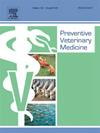Risk factors for the incursion of highly pathogenic avian influenza virus into poultry and other captive bird holdings in Denmark from 2020 to 2023: A case-control study
IF 2.2
2区 农林科学
Q1 VETERINARY SCIENCES
引用次数: 0
Abstract
Highly pathogenic avian influenza (HPAI) is a major concern in terms of animal and human health. Between October 2020 and September 2023, there were 36 HPAI outbreaks detected in poultry and other captive birds in Denmark. However, it is often not possible to determine the exact route of introduction. We conducted a case-control study to compare the odds of exposure to a range of potential risk factors for HPAI virus incursion into Danish poultry or other captive bird holdings with HPAI outbreaks (cases) and with no HPAI outbreaks (controls) during the HPAI epidemiological seasons 2020/2021, 2021/2022 and 2022/2023. The owners of 38 % of the eligible case holdings and 45 % of the eligible control holdings declined to participate, suggesting that HPAI virus infection is a sensitive subject for some owners. The study population included 18 cases and 34 controls. We collected data primarily through questionnaire-based interviews and estimated odds ratios (OR) within a Bayesian framework using a Beta conjugate prior to define the odds directly, with Monte Carlo integration from these posterior distributions of odds to estimate the relevant OR with 95 % credible intervals (CI) and Bayesian p-values. The results indicated that the odds of observing wild waterfowl or gulls on the roof or around farm buildings compared to observing none within 500 m of the holding was higher for case holdings (OR: 18.7, 95 % CI: 3.1–148, p: 0.022). This information can be used for future risk-based monitoring, biosecurity management and placement of captive bird holdings.
2020 年至 2023 年高致病性禽流感病毒侵入丹麦家禽和其他圈养鸟类的风险因素:病例对照研究。
高致病性禽流感(HPAI)是动物和人类健康的一大隐患。2020 年 10 月至 2023 年 9 月期间,丹麦在家禽和其他圈养鸟类中发现了 36 起高致病性禽流感疫情。然而,通常无法确定确切的传入途径。我们开展了一项病例对照研究,以比较在 2020/2021、2021/2022 和 2022/2023 年高致病性禽流感流行季节期间,丹麦家禽或其他圈养鸟类饲养场中发生高致病性禽流感疫情(病例)和未发生高致病性禽流感疫情(对照)时接触一系列高致病性禽流感病毒潜在风险因素的几率。38% 的符合条件的病例饲养场和 45% 的符合条件的对照饲养场的所有者拒绝参与,这表明高致病性禽流感病毒感染对一些所有者来说是一个敏感话题。研究对象包括 18 个病例和 34 个对照。我们主要通过问卷访谈收集数据,并在贝叶斯框架内估计几率比(OR),使用贝塔共轭先验直接定义几率,然后根据这些几率的后验分布进行蒙特卡罗积分,以估计相关的几率比,并得出 95% 的可信区间 (CI) 和贝叶斯 p 值。结果表明,在农场建筑物屋顶或周围观察到野生水禽或海鸥的几率要高于在农场 500 米范围内观察不到任何野生水禽或海鸥的几率(OR:18.7,95 % CI:3.1-148,p:0.022)。这些信息可用于未来基于风险的监测、生物安全管理和圈养鸟类的安置。
本文章由计算机程序翻译,如有差异,请以英文原文为准。
求助全文
约1分钟内获得全文
求助全文
来源期刊

Preventive veterinary medicine
农林科学-兽医学
CiteScore
5.60
自引率
7.70%
发文量
184
审稿时长
3 months
期刊介绍:
Preventive Veterinary Medicine is one of the leading international resources for scientific reports on animal health programs and preventive veterinary medicine. The journal follows the guidelines for standardizing and strengthening the reporting of biomedical research which are available from the CONSORT, MOOSE, PRISMA, REFLECT, STARD, and STROBE statements. The journal focuses on:
Epidemiology of health events relevant to domestic and wild animals;
Economic impacts of epidemic and endemic animal and zoonotic diseases;
Latest methods and approaches in veterinary epidemiology;
Disease and infection control or eradication measures;
The "One Health" concept and the relationships between veterinary medicine, human health, animal-production systems, and the environment;
Development of new techniques in surveillance systems and diagnosis;
Evaluation and control of diseases in animal populations.
 求助内容:
求助内容: 应助结果提醒方式:
应助结果提醒方式:


